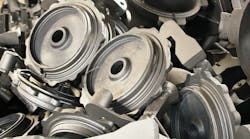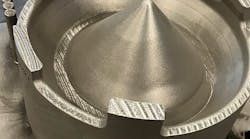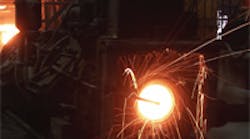Mitchell Kidd, vice president and general manager of one of the Northeast’s largest producers of ductile iron pipe, could see the regulations for mercury emissions on the horizon. By 2010, all foundries and steel mills in the state would be required to meet the mercury emissions standards established by the New Jersey Department of Environmental Protection (NJDEP), but Kidd saw this as an opportunity to be an industry leader.
“Even though we have been in compliance regarding emissions control, we wanted to take the necessary action regarding mercury — without waiting until 2010,” says Kidd, who heads Atlantic States Cast Iron Pipe in Phillipsburg, NJ.
New Jersey’s 2010 standards will require a mercury emission rate of 35 mg/ton of steel by using mercuryfree scrap metal, or 75% control efficiency by installing and operating controls to an existing emission control system.
What made this project more ambitious is that mercury emissions are not included in the U.S. EPA’s Maximum Achievable Control Technology (MACT) standards for cupola melting: MACT addresses more than 300 hazardous air pollutants across a variety of industries, but not mercury.
Attempting to capture mercury emissions from a cupola while achieving MACT compliance had never been attempted before in North America. Kidd recognized he’d need a partner with the technical expertise to design and install a new emissions-control system, but also experience in removing mercury. Those dual objectives pointed the selection to Kuttner North America (www.kuttnerna.com).
“Kuttner’s team is extremely knowledgeable at the highest levels of the company, with valuable technical experience,” said Kidd. “More importantly, they were the only company we talked to that had experience in removing mercury and were able to take us to sites where systems were in place and show actual results.”
Beyond compliance
Before the new system was installed, Atlantic States relied on a wet scrubber system to clean cupola emissions, a process that relies on collisions between droplets of water and the particulate of the furnace emissions. Although this approach to emissions control complies with current regulations, it would not achieve the new level of control required by New Jersey after 2010, nor would it go beyond compliance as directed by Kidd and Atlantic States.
In contrast to the plant’s original system, Kuttner’s solution uses Luehr’s (www.luehr-filter.de) patented baghouse technology and Powdered Activated Carbon (PAC), a highly adsorbent form of carbon, to remove odors and emissions from liquids or gases. But, simply injecting carbon into the system won’t generate the results New Jersey will require, either.
For PAC to be effective, a reaction between the mercury and activated carbon is required, and it must occur in a few critical seconds before the gases reach the bag filter. Kuttner uses a perforated drum filled with ceramic balls to provide the surface area needed for the reaction. As the drum rotates, it almost becomes a fluidized bed of material. The result is a significant amount of contact between the gases and the PAC, even in a short timeframe.
“What is unique about our system is that we introduce the carbon upstream from the baghouse, approximately a football field away,” said Kidd. “The result is an additional second-and-a-half of reaction time between the gases and the carbon, which we believe is significant.”
Before the gases reach the baghouse, the Kuttner system uses a heat-recovery unit to cool the combustion gases down to 280°F as they enter the baghouse. According to Kidd, the lower operating temperature and the ability to control the temperature of the gases is important when attempting to remove mercury.
“We selected this system because it is an oil-based cooling system and the Kuttner system delivers precise temperature control. The temperature needs to be somewhere between the acidic dew point for sulfuric acid and the volatile nature of mercury,” said Kidd. “If the temperature is too low, you’ll have precipitating acid in the baghouse, which will corrode the baghouse dramatically. If you don’t cool it down enough, you won’t reach the point where the vapor pressure of mercury is low enough to catch it.”
State-of-the-art monitoring
In addition, the lower temperature also serves as a safety feature to minimize significantly the chances of a reaction between activated carbon and any oxygen molecules within the system, which could result in a fire.
Kuttner’s advanced system uses a very low air-tocloth ratio. The Luehr filter bags are so compact that more than 6,500 of them fit into Atlantic States’ customdesigned baghouse. This translates to more than 60,000 ft2 of available surface area. The low air velocity, coupled with the high surface area afforded by the Kuttner design, leads to the highest possible efficiency. This is critical to the amount of dust collected and achieving the highest emissions control possible.
Because of the flexibility of the components, Kuttner was able to fit the baghouse into a very tight location, yet still achieve an extremely high filter surface area. Kuttner used four collectors stacked in a 22 configuration. Normally, all four operate side-by-side in a straight line. A baghouse using this industry standard design would be too large to achieve the results required, and fit into the available space.
“The recycling nature of Kuttner’s baghouse is also very unique. There is the potential for a high recycling ratio of dust that is re-circulated into the system,” said Kidd. “This leads to high mercury capture and lower PAC usage, which makes the system operate more efficiently, and reduces operating costs.”
Along with Kuttner’s emissions-control system, Atlantic States took another unique approach to monitoring mercury. The company located a continuous emissions- monitoring system (CEMS) specifically designed for mercury in Germany. Although most states don’t require a CEMS, Kidd says this piece of equipment was invaluable during the installation.
“A lot of very knowledgeable people said the only thing more difficult than removing the mercury would be to measure it,” said Kidd. “A CEMS used for mercury is a tough piece of equipment to keep calibrated, and the gases are expensive to do it. Plus, the technical support and repair people are overseas. We only used it to troubleshoot during the debugging and optimization of the system. We could see that when the PAC runs, the mercury is undetected. It’s just that simple. ”
Unprecedented results
Running two shifts a day, six days a week, Kuttner completed the project within the proposed six-month timeframe. Operating within an extremely tight footprint, Kuttner had a four-hour-window in the middle of the night to bring components in for staging and installation the following night. At times, a crane was used to lift the semi-truck trailer used to bring in the equipment and turn it around so it could be driven out.
The hard work paid off in December 2006, when a stack test revealed the foundry had achieved mercury emissions of less than 2 mg/ton, and that its mercury removal rate exceeded 99%. Both measurements are well beyond the level of compliance required by the NJDEP — 35 mg/ton.
Not to mention, Atlantic States was three years ahead of the state regulators’ compliance schedule. It is projected that this system will remove more than 200 lbs. of mercury before the NJDEP regulations even go into effect.
But, mercury emissions weren’t the only areas where
Atlantic States saw a reduction in emissions. The stack test also revealed:
• A reduction in lead emissions to 0.00039 lb./hr, or 99.9% removal;
• Significant reduction in particulate matter emissions;
• Reduction in carbon monoxide emissions of 95%; and
• Significant reduction in the emission of other metals
While emissions control was the main objective, Kuttner’s solution is designed to maximize the efficiency of the furnace and minimize electricity and natural gas consumption. It adds that it offers “a total package solution” that also reduces operating and maintenance costs.
“I’d say we’ve reduced the maintenance requirements by 90%,” Kidd says. “In addition, the design and positioning of the filters does not require any offline cleaning so we don’t have to shut down the flow of the collector.”
Atlantic States’ original scrubber used a 1,200-hp primary exhaust fan, which typically ran “wide open” at all times. The Kuttner system’s primary exhaust fan is rated at only 800 hp and is equipped with a variable-frequency drive so that it only uses the power required at a particular time.
Kidd says the fan typically runs at the maximum capacity twice daily. The rest of the time it’s running at approximately 60% of capacity. By his estimate, the energy reduction and savings are approximately 25%, but Kuttner’s system generated results that were more easily identifiable by the community.
“The old scrubber had a very high pitch sound to it, but with our new system, people can’t tell we’re operating, which is a good thing,” said Kidd.
Another familiar trademark of the old system is gone as well. Now, when Kidd looks out from the Atlantic States facility there isn’t any plume of steam from the cupola, because it’s been eliminated by the Kuttner emissions-control system.
Kidd’s outlook now stretches beyond the plant site, to the future of domestic metalcasting and the example Atlantic States will set – that’s what industry leaders do.
“We hope to help teach others and communicate our successes to those who follow behind us,” said Kidd. “It was a very involved, technical project, and working with Kuttner, as well as the Environmental Protection Agency and NJDEP, we achieved something that hadn’t been done. Our role within the industry will be to help others meet these new regulations and go beyond compliance.”















